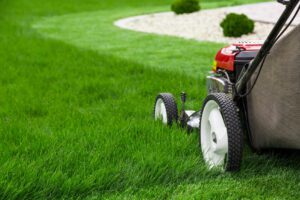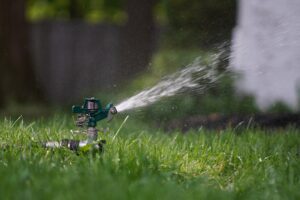Fall is upon us – it is now “pumpkin spice” season. For those who live in northern Illinois thoughts have moved from the 4th of July and Labor Day to Halloween and Thanksgiving. Before we get to those two holidays though, it’s time to prepare the lawn for winter.
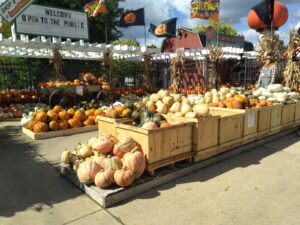
To prepare your lawn for the uncertain Illinois winter, consider these 10 things –
1. Get rid of the weeds
Weeds left in the lawn over the winter will come back to taunt you again in the spring – just bigger and bolder. Pull them if you can or spot treat them with a chemical herbicide that kills weeds and not grass. Keep in mind that not all lawn-friendly herbicides work on all varieties of lawn weeds. When possible, identify the weed (broad-leaf, grass-like or grassy) and use a product that is designed to kill that type of weed. 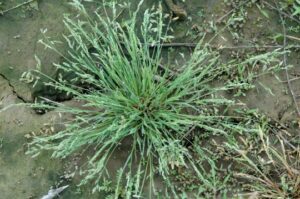
Granular weed and feed products are not the best option for fall. Stick with a liquid herbicide that you spray onto each individual weed. If you’ve got way too many weeds so that spot treatment is not really practical, go with a hose end liquid applicator that makes the job much more manageable. Again, be certain that it kills weeds only and not weeds and grass. (If you’re planning on over-seeding before the end of the season, plan you weed extermination about 3 weeks before you lay down grass seed.)
- Remove the leaves
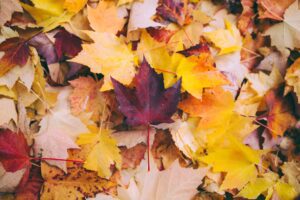 Clear your fallen leaves to prevent suffocating the grass and promoting disease. Don’t leave leaves and debris on your lawn over the winter. Cleaning up the lawn in the fall is a critical step toward proper winterization. This task is one of the last of the seasons, so don’t skip it. Leaves and thatch left on the lawn over the winter block sunlight and trap moisture which can lead to snow mold and other fungal problems. And, it’s best not to wait for the trees and shrubs to drop all of their leaves — so rake weekly or as needed.
Clear your fallen leaves to prevent suffocating the grass and promoting disease. Don’t leave leaves and debris on your lawn over the winter. Cleaning up the lawn in the fall is a critical step toward proper winterization. This task is one of the last of the seasons, so don’t skip it. Leaves and thatch left on the lawn over the winter block sunlight and trap moisture which can lead to snow mold and other fungal problems. And, it’s best not to wait for the trees and shrubs to drop all of their leaves — so rake weekly or as needed.
Remove as many leaves, sticks, and other debris as possible from your lawn. We don’t recommend mulching and leaving leaves on the ground over winter. If you prefer to get them off the lawn by using your mulching mower, bag them up and recycle them in your compost pile.
- Core aerate your lawn
Soil compaction prevents water and nutrients from reaching the root zone and impacts root growth. This can be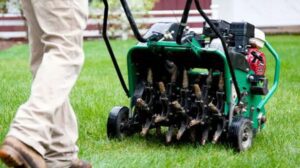 easily addressed by core aeration. Aerating the soil allows better water and nutrient absorption. Fall is a good time for this, as it helps with root growth. Compacted soil leads to an unhealthy lawn – grass will be thin and weak and the compacted soil actually encourages the propagation of weeds.
easily addressed by core aeration. Aerating the soil allows better water and nutrient absorption. Fall is a good time for this, as it helps with root growth. Compacted soil leads to an unhealthy lawn – grass will be thin and weak and the compacted soil actually encourages the propagation of weeds.
You should plan on doing your aeration when the soil is moist but not soggy. If your lawn is dry, simply water it well the day before you aerate. Soil that is dry is almost impossible for the aeration tines to penetrate. Soil that’s too wet will clog the tines, the wheels and the drive mechanism of the machine and leave you with a big mess! Even though they may be unsightly, leave the core plugs on your lawn, they will breakdown fairly quickly and they add nutrients to your lawn. And, if you planning on over-seeding, this is a great time to do so.
If core aeration or power raking with a de-thatching machine is not possible or practical for you, use a tine rake or de-thatching rake to pull up the excess thatch that’s choking your grass.
- Over-seed your lawn
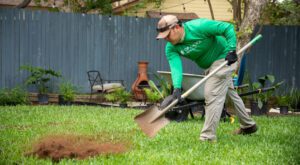 Although not a requirement for winter lawn prep – and not always a “must do” annual chore, re-seeding bare, brown patches or thin areas in your lawn encourages new grass growth. Our Top-dressing Mix (50% topsoil / 50% fine sand) is a great product to use if you need to fill bare spots, fix patchy grass or level your yard. Be sure to use a grass seed blend that addresses you lawn’s specific light situation: all sun, sun and shade or all shady. Bags of ready-to-use grass seed you purchase from the big box stores is not your best choice. Adding a quality starter fertilizer after the top-dressing and over-seeding will help insure faster grass germination.
Although not a requirement for winter lawn prep – and not always a “must do” annual chore, re-seeding bare, brown patches or thin areas in your lawn encourages new grass growth. Our Top-dressing Mix (50% topsoil / 50% fine sand) is a great product to use if you need to fill bare spots, fix patchy grass or level your yard. Be sure to use a grass seed blend that addresses you lawn’s specific light situation: all sun, sun and shade or all shady. Bags of ready-to-use grass seed you purchase from the big box stores is not your best choice. Adding a quality starter fertilizer after the top-dressing and over-seeding will help insure faster grass germination.
- Mow a bit lower
![]()
Before you lawn goes dormant for the season, cut your grass to a shorter length for the last mowing of the season. This prevents disease and rodent problems during winter. Taller grass can leave your lawn susceptible to snow mold and other funguses in the spring. A low lawn mower height promotes top half grass health come spring and will keep it greener throughout the winter. And as a reminder: Keep that mower blade sharp.
- Fertilize
Apply a slow-release fertilizer in the late fall. This provides nutrients to your grass during the winter months. This should be completed around one to two weeks after your core aeration and last mowing – just before the weather gets cold and the ground freezes. Use a fertilizer specifically formulated for late fall application. This is NOT a time for a weed and feed product. You want a lawn food product. Some stores will market fall fertilizers as winter fertilizer, and that’s okay. The nitrogen and potassium in that product will be stored in the soil over winter and then utilized in the spring when outside and soil temps rise. Nitrogen helps promote greening, growing, and thickening faster in the spring than if you skipped winter fertilizer. The potassium promotes all-round plant health and development.
 Too much nitrogen however, actually promotes the growth of fungus disease such as snow mold. Here at Tim Wallace Supply we recommend an application of our Lawn Repair Mix as a powerful, safe and effective natural alternative to fall season chemical fertilizers.
Too much nitrogen however, actually promotes the growth of fungus disease such as snow mold. Here at Tim Wallace Supply we recommend an application of our Lawn Repair Mix as a powerful, safe and effective natural alternative to fall season chemical fertilizers.
This natural soil amendment blends the 3 top beneficial products your lawn needs most – and in the optimal percentages: 50% topsoil, 25% fine sand and 25 % Purple Cow Classic compost. (Purple Cow Classic Compost is 100% plant based finely screened, manure, weed seed and pathogen free.) It can be used as an effective top-dressing for overseeding or as a stand-alone topdressing mix (think natural fertilizer). Either way it’s used you will see lawn improvement.
- Consider Fungus prevention
Apply a fungicide at this time too if snow mold has been an issue in the past. This is best done just before the hard frost for optimal winter protection as a preventive measure. Applying chemical treatments after the snow mold has appeared will do very little to help the problem.
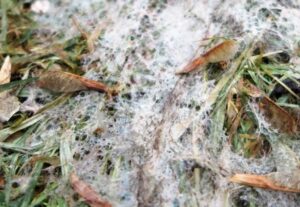 Snow mold occurs when the grass freezes and thaws throughout the winter season. Grass that has been left cut too high will have a tendency to fold over onto itself and become matted. This creates a favorable breeding ground for turf fungus. And as previously addressed, unraked leaves will smother the grass which can also lead to snow mold which will appear in the spring.
Snow mold occurs when the grass freezes and thaws throughout the winter season. Grass that has been left cut too high will have a tendency to fold over onto itself and become matted. This creates a favorable breeding ground for turf fungus. And as previously addressed, unraked leaves will smother the grass which can also lead to snow mold which will appear in the spring.
There are two types of snow mold: gray or pink. Gray snow mold will damage only the blades of the grass, while the pink snow mold – being the more serious kind, can destroy both the root system and crowns of the grass. Again, prevention at this point in late fall is your best option. A product that should be readily available at any garden supply store that works for both gray and pink snow mold prevention is Bio-Advance Fungus Control for Lawns (granular).
- Water your yard
![]()
When you steadily water until the ground freezes it helps ensure that your grass is well-hydrated before winter. Also, some shrubs and bushes like Boxwoods and non-deciduous evergreens like Arborvitae are susceptible to Winter Burn. This manifests as dead or brown sections on an otherwise healthy plant. There is no real treatment for Winter Burn short of cutting out the affected area(s). Water until the ground freezes. That way you ensure that all of your plants take up enough water to help them through their winter dormancy.
- Protect your lawn from excess traffic
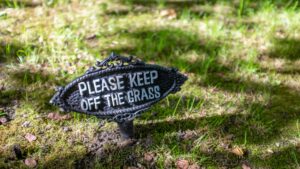 Minimize foot and vehicle traffic on the lawn to prevent compaction and damage. A dormant lawn is susceptible to compaction and long-term compression damage. To minimize winter damage, avoid walking on your dormant lawn and definitely don’t move heavy landscape equipment across it. (And, try to avoid or reduce altogether getting ice melt products onto you grass. Damage from ice control products will show up in early spring.)
Minimize foot and vehicle traffic on the lawn to prevent compaction and damage. A dormant lawn is susceptible to compaction and long-term compression damage. To minimize winter damage, avoid walking on your dormant lawn and definitely don’t move heavy landscape equipment across it. (And, try to avoid or reduce altogether getting ice melt products onto you grass. Damage from ice control products will show up in early spring.)
10: And don’t forget to winterize your lawn and garden equipment
- Drain the fuel or add a gas stabilizer
- Clean off any dirt, clippings, debris or spilt oil residue
- Replace the air and gas filters
- If your equipment has one, be sure to disconnect and pull the battery
- Change the oil
At Tim Wallace Soil Mix Supply, we sell the best products for the best results. Our friendly lawn and garden advice however is always free. When you search for fall lawn care, lawn repair and renovation or fix my lawn, search not farther than Tim Wallace Soil Mix Supply. Call us today – (630) 759-1080.


